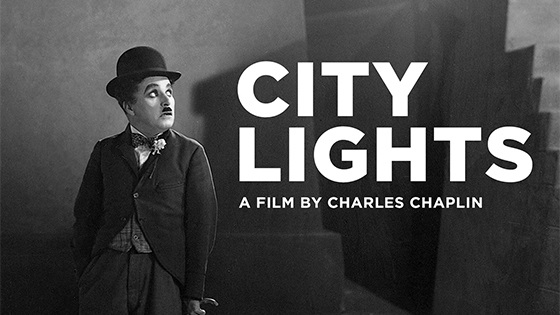
Image courtesy of amazonaws.com
Rhett and Scarlett, Rick and Ilsa, Tony and Maria… in every list of cinema’s most iconic couples, these duos always make the grade. Even though other couples may not have the ubiquity nor the pop cultural standing of the aforementioned three, they merit mention at one point or another, which makes the constant omission of my personal favorite – the Tramp and the Blind Girl – all the more an injustice.
“City Lights” (1931) with Charlie Chaplin and Virginia Cherrill in the lead roles is a film that transcends a genre. It’s a romance and it’s a comedy, yet to call it a romantic comedy would not be right. “City Lights” is not structured according to the prescribed formula of boy meets girl/conflict separates boy from girl/boy and girl reunite as they resolve a series of humorous misunderstandings. A courtship doesn’t happen. Nobody’s love is scorned. The Tramp and the Blind Girl both get what they want in the end. All ought to be sunshine and daisies. It isn’t.

Image courtesy of images4.fanpop.com
The Tramp and the Blind Girl meet on a street corner where the Blind Girl is selling a basketful of flowers. Upon hearing his passing footsteps, she offers the Tramp a flower to buy, which he does with money he scrounges from his pocket. He realizes that she assumes he is a wealthy gentleman when the door to a car parked in front of them opens and shuts, for she calls out to the real gentleman who has boarded the car and driven away that he has forgotten his change. The friendship that develops between the two with subsequent visits to the street corner takes a turn as the Tramp chances upon a newspaper notice for an experimental surgery that restores vision. From then on, the Tramp and the Blind Girl share one dream. Still, there is a grave matter that needs to be settled; the Blind Girl and her grandmother are about to be evicted. To raise rent, the Tramp falls into money-making schemes, all of which prove to be preposterous because that is the life of the Tramp.
“City Lights” was made when talkies were exploding. Charlie Chaplin, however, wanted a silent. The result is a love story so delicate that it flitters across the screen as if it were a dream. Regardless of how many times the Tramp falls on his ass, he gets back on his feet, ennobled by a selfless desire – for a blind girl to have the comfort of a home and the blessing of sight while he asks for nothing in return. Such nobility in the face of humiliation was a matter of survival during Depression Era America. Men labored under the sweltering sun, picked grapes for a pittance, no matter that the future promised nothing; their families depended on them. So it is with the Tramp. He knows from the start that he might never get the girl. It is her happiness that matters, not his, and knowing that he would be the man to grant her that happiness is enough of a future for him to endure any indignity.

Image courtesy of fotosearch.com
As with all films that celebrate the most coveted communion between two people and the sacrifices it entails, “City Lights” makes me mull over what I would do for that person:
- I would give him the single parachute in a plane about to hit a mountain wall
- I would face a firing squad without a blindfold
- I would hold him close on a cold night for my heat to warm his blood
- I would tickle his ear with my tongue to make him laugh when he’s sad
- I would author a novel dedicated to him
I do have my limits, however. I wouldn’t use his toothbrush, and to take the fall on his behalf for something of which I am guiltless, I’d have to think about that. A life behind bars could be worse than death; death is a form of freedom. Decisions. Decisions. Should any of us find ourselves in this crisis, we have Charlie Chaplin to teach us a thing or two about the right choice. Again, “City Lights.” Time passes. The Tramp is in worse condition than before. Coat torn at the seams, holes in pockets, he wanders the streets an object of derision as boys shoot pellets at him. He is annoyed, nothing more… not angry, not bitter… no matter what atrocities life had done him. Even then, his annoyance passes. Such is the nature of the Tramp – upbeat against all odds – which makes the finale to “City Lights” the most poignant in all filmdom.
:origin()/pre14/4c85/th/pre/i/2014/118/1/d/fake_smile_by_marii85-d7cxieo.jpg)
Image courtesy of t13.deviantart.net
I wish you could experience it as I did, to the movie score Chaplin had composed as performed live by the San Francisco Symphony, only words for the pounding of drums and clashing of cymbals in simulating the beating of a weeping heart are beyond my vocabulary. Instead, I offer you another Chaplin treasure:
Smile though your heart is aching. Smile even though it’s breaking. When there are clouds in the sky, you’ll get by. If you smile through your fear and sorrow, smile and maybe tomorrow, you’ll see the sun come shining through for you.
On his way the Tramp goes, past the flower shop where the Blind Girl works, she prettied up in a lace-collared dress and heels. Everything he did for love has paid off. The beauty of the world is now hers to relish, an existence far from shabby dwellings, poverty, and homeless riffraff. In her joy he has found his own. That’s the way it is. Sometimes we need to lose in order to share with the person we most care about a piece of paradise. In other words: when you love someone, free, free, set them free. Sorry for the hokum, but Charlie Chaplin was the first to visualize it in a story unique to him. And when these words appear before us in a cloud thought to sum up a situation we’re in, the jab to the heart really does puncture.

Image courtesy of franklintheatre.com